Wealth in Waste: India’s Potential to Bring Textile Waste Back Into The Supply Chain
Annexure
ANNEXURE 1: GLOSSARY
ABBREVIATIONS
CI
Collective Impact
DWCC
Dry Waste Collection Centre
EPR
Extended Producer Responsibility
EU
European Union
FFG
Fashion For Good
GDP
Gross Domestic Product
GRS
Global Recycled Standard
HS Code
Harmonised Commodity Description and Coding System
ICD
Inland Container Depots
KASEZ
Kandla Special Economic Zone
MFA
Multi-Fibre Arrangement
MMCF
Man-Made Cellulosic Fibres
MSW
Municipal Solid Waste
NGO
Non-Governmental Organisation
PPE
Personal Protective Equipment
PRO
Producer Responsibility Organisation
RCS
Recycled Claim Standard
RMG
Readymade Garments
RoI
Return on Investment
RR
Reverse Resources
SEZ
Special Economic Zone
SZW
Saahas Zero Waste
T&A
Textiles and Apparel
USA
The United States of America
KEY TERMS AND DEFINITIONS
Blowroom Waste
Blowroom is an initial stage in the spinning process. The waste that comes out of this is called blowroom waste.67
Carding Waste
Waste that is generated in the carding stage of spinning is called carding waste.
Commercial all wool (CAW)
Comprises of woollen sweaters, scarves and knits clothing (second-hand or mutilated)
Chindi/Katran
A ‘torn cloth’ generated at the cutting table during the garmenting manufacturing process. ‘Katran’ also means scrap of cloth.
Chindi Durries
Rugs made by weaving 1ft long chindi on a handloom
Colour
The colour of an article is considered the solid or dominant colour. If it is not possible to define a singular dominant colour, the article is to be considered multicoloured. The dominant colour categories for the analysis will be predefined and added to the annex in this handbook.
Comber noils
Cotton Comber or Comber Noil is a by-product of the yarn spinning industry produced when cotton is combed to remove short fibres.68
Deadstock
Leftover, remnant, or scrap fabric which is either from the previous season or is a rejected roll of fabric [more than 10m]
Disruptors
A hard point that may be a disruptor to the recycling process present on an itemof clothing (eg. fastener, button, zipper, etc.) which can be found in metal or plastic materials and can usually be the object of disassembling operations in preparation for recycling.
Downcycling
Reprocessing discarded textiles to create new consumer or industrial products, in a process that is usually mechanical (cutting, shredding, bonding). Discarded textiles are no longer in their original form, and new products do not re-enter the textile supply chain, resulting in a subsequent use that is of lower value than the original source of the material.69
Fancy
A bale with garments that have multiple colours, in addition to threads, checks, tweeds etc.
Fabric scrap/ cuttings
A ‘torn cloth’ generated at the cutting table during the garmenting manufacturing process. Fabric scrap/cuttings might be generated at sewing floor as well but in significantly low quantity as compared to cutting waste
Feedback Loop
A feedback loop is the part of a system in which some portion (or all) of the system’s output is used as input for future operations.70
Fraction
Categories by which collected used textiles are sorted into for different reuse and recycling purposes, which are sold on different local and global markets.71
Garbage
Refers to all garments that are of no use for a particular recycler. In general, polyester materials are referred to as ‘garbage’ in the industry.
Grade
Quality level by which collected used textiles are sorted, defined as grades, and sold both for reuse and recycling in different fractions (eg. Cream, A, B, C).72
High-Grade Recycling
Refers to the process where textile waste material are recycled into yarns of a closer quality to the virgin quality (> 20 Ne count)
Industrial Symbiosis
The use of one industry’s waste as another industry’s resource (very often via downcycling). It is important to note that it is different from textile-to-textile recycling and fibre-to-fibre recycling. A typical example is usage of textile waste in insulation panels manufacturing, automotive industry or cleaning textiles.
Low-Grade Recycling
Refers to the process where textile waste material are recycled into yarns of a lower quality (<= 20 Ne count)
Marbet
Bigger cut panels (usually a cutting of the neck piece of a t-shirt)
Mechanical fibre-to-fibre recycling
Mechanical recycling of cotton fibres to cotton fibres. In this process, typically textile cutting waste and yarns are torn and opened up into a fibre form ready to be re-spun again. Typically, this recycled fibre needs to be blended with a virgin fibre to achieve higher quality/strength
Mono-layer
Products that are made from one layer or type of textile73
Multi-layer
Products that are made from more than one distinct layer, each of which may be composed of different materials. There are two types of multi-material garments:
- True multilayer = “Several main layers’’. Refers to an article consisting of at least a second layer representing more than 1/3 of the surface of the article (eg. jacket lining)
- Monolayer + others = “1 main layer and 1 or more auxiliary or minority layers”: article made up of a main layer with the presence of other minority layers representing less than 1/3 of the surface (eg. pocket bottom, badge, yoke, embroidery, lace)
Non-rewearable
Garments that cannot be reused in their original form and are made from one or multiple types or layers of textiles. This category is known as ‘material reuse’ among many textile collectors/sorters.74 This category is considered the ‘Black fraction’ in this study and includes:
- Materials for recycling / garneting: Garment textile products which are meant to be shredded or garnetted (opening up the fabric into a fluffy, fibrous condition for reuse)75, with a purpose of future use of these fibres for recycling into insulation, automotive, mattress filling, yarn or other.
- Materials for wiping: Various rags (mainly cotton) used for cleaning machinery as well as for hand wiping.76
- Fibres and materials destined to become refuse-derived fuel: Fibres and materials from garment textile products that are used to produce Refuse Derived Fuel (RDF) to ultimately produce energy and heat.77
- Ultimate waste: Wet, damp, damaged garment textile products which are not fit to be sold in reuse or recycling markets.
Original Wool Rug (OWR)
Includes garments that have wool content and other fabrics. For example, coats, jackets and outerwear (second-hand or mutilated)
Original
A bale which contains both uni and fancy garments
Patti
Longer strips of fabric generated during the cutting stage of apparel manufacturing
Pre-consumer
Pre-consumer waste includes all post-industrial waste as well as any leftover/unsold materials or products such as fabric ends, unsold garments, etc.
Pneumafil
Pneumafil Cotton Waste is obtained during the process of yarn production. It consist of homogenous fibres, available in thickness ranging from 24-28mm78
Post-industrial
Any waste that gets generated as a by-product of industrial processes such as milling, spinning, printing and garmenting. This waste is a subset of the pre-consumer wast
Rags/Mutilated fabrics
Waste pieces of cloth which are either old, torn or in any other ragged condition. It can be interchangeably with mutilated clothes.
Regenerative blended recycling
Non-mechanical methods to convert blended fibres into separated outputs of cellulosic pulps, polyester fibres or pellets
Regenerative cellulosic recycling
Non-mechanical methods to convert cotton and cellulosic fibres into virgin-like cellulosic pulp
Regenerative synthetic recycling
Non-mechanical methods to convert used mono-synthetic like polyester and nylon fibres into virgin equivalent PET chips and fibre or nylon flakes
Rewearable
Garments that can be reused in their original form, for their original purpose. This category is known as ‘product reuse’ among many textile collectors/sorters.79 In this study, rewearables are represented by the ‘White’ and ‘Grey’ fractions
Shoddy/Mungo mills (England)
Shoddy is an inferior woollen yarn made by shredding scraps of woollen rags into fibres, grinding them and then mixing them with small amounts of new wool. Mills in Panipat working with wool waste are referred to as ‘Shoddy Mills’.
Sweep Waste
It is a mixed waste generated in the cotton spinning process. It is ideally the waste that spills over during production and is later collected while cleaning.
Textile-to-textile recycling
In the context of this study, this encompasses all textile recycling processes where the output is used again in this specific sector, in similar applications for which it was first developed.
Thapki
Bigger cut panels and end rolls
Trims
A hard point that may be a disruptor to the recycling process present on an item of clothing (eg. fastener, button, zipper, etc.) which can be found in metal or plastic materials and are usually the object of disassembling operations in preparation for recycling. See list of relevant hardware in the annex of the Handbook for Sorters.
Uni
A bale that has single coloured garments
Yarn Waste
Residual yarns which are left on the cones after warping are considered wastages.80
KEY TERMS AND DEFINITIONS (UNITS)
INR
Indian Rupee (1 INR= USD 0.000128)
Ktons
A unit of weight or capacity equal to 1,000 metric tons
mn
Million
Mtons
The Metric Ton is 1,000kg
Ne Count
The yarn count is a numerical expression which defines its fineness or coarseness
USD
US Dollar = INR 78.0381
ANNEXURE 2: TABLE OF ROLES AND RESPONSIBILITIES CARRIED OUT BY STAKEHOLDERS ACROSS ALL WASTE STREAMS
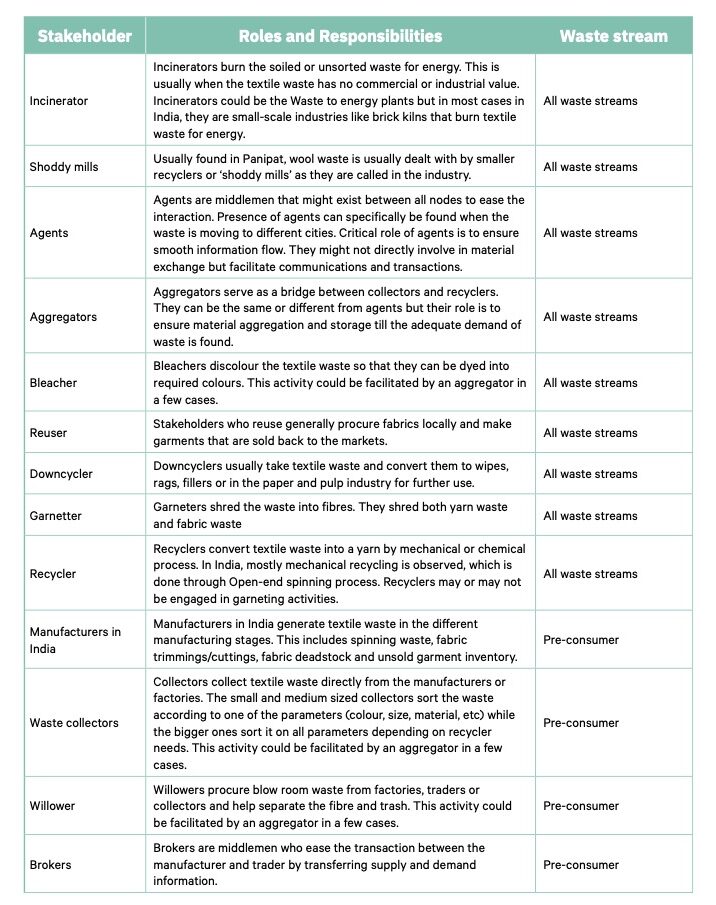
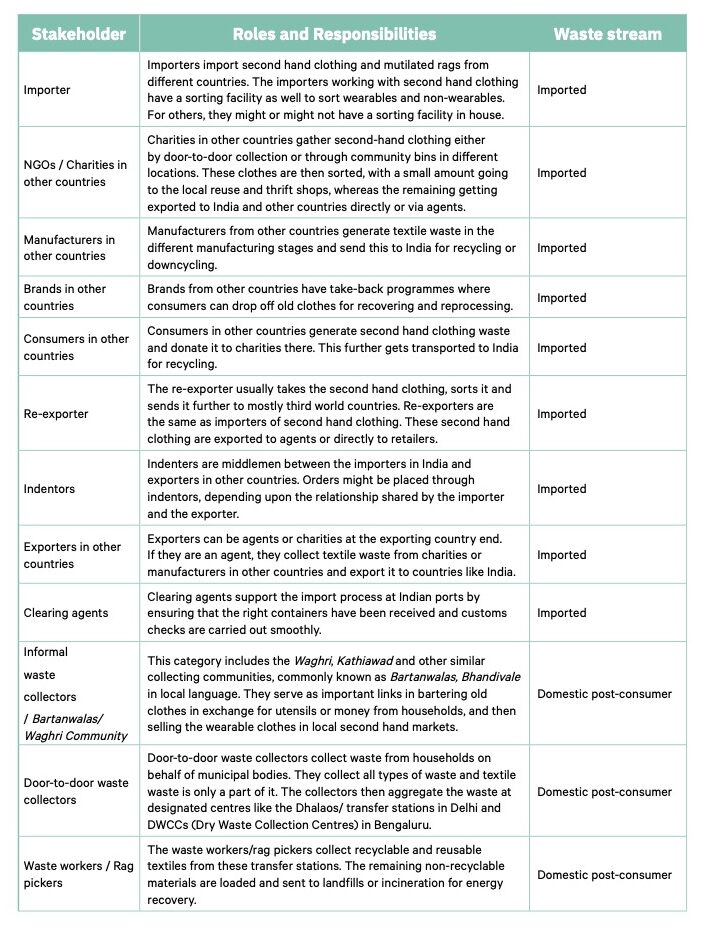
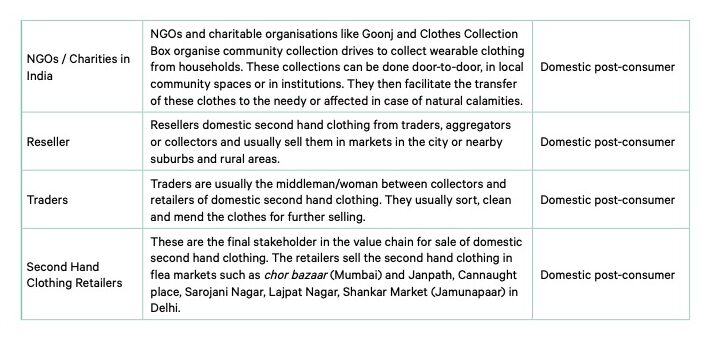
ANNEXURE 3: DETAILED FLOW OF DOMESTIC POST-CONSUMER WASTE ACROSS DELHI AND BANGALORE
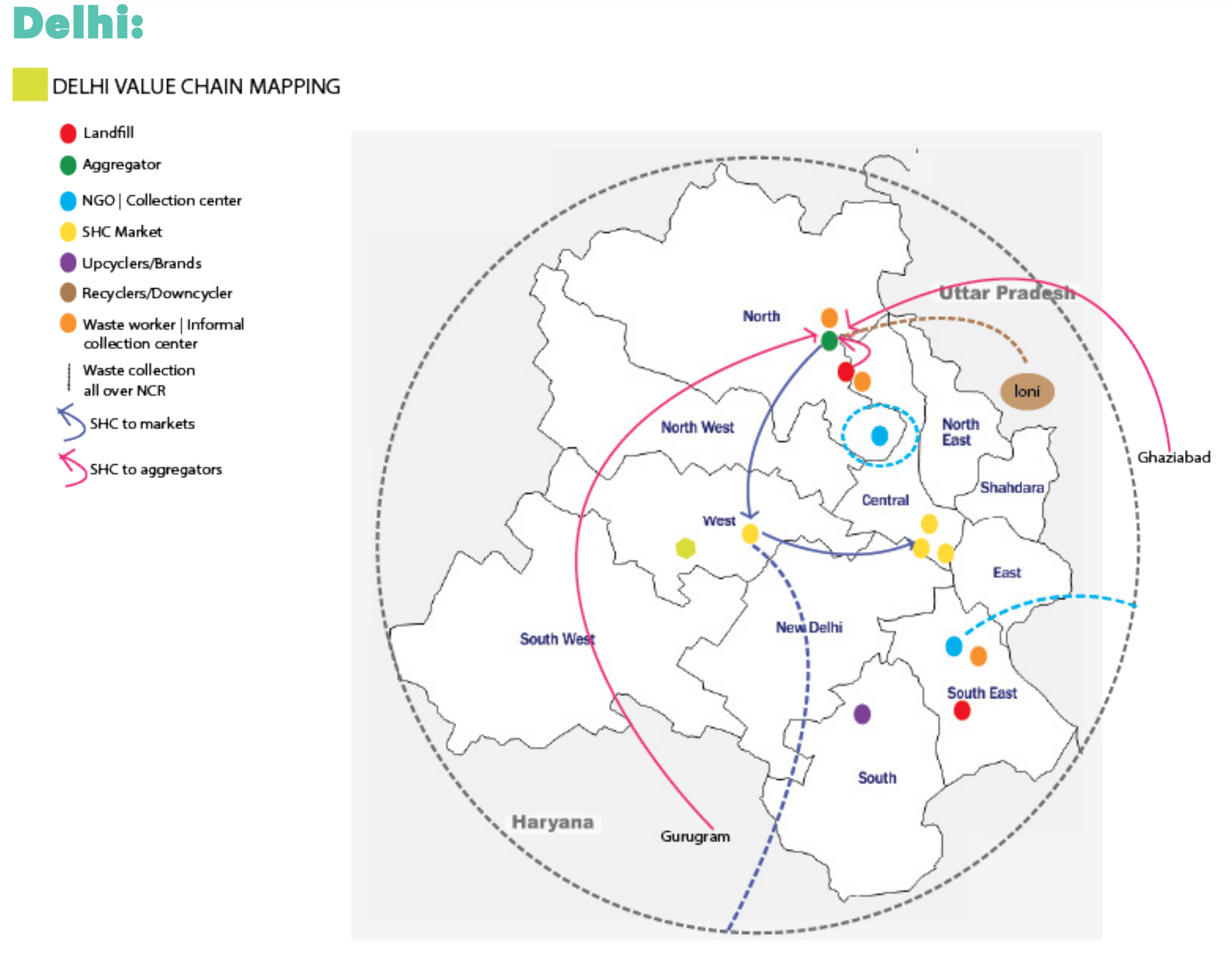
Illustration 38: Flow of domestic post-consumer waste in Delhi
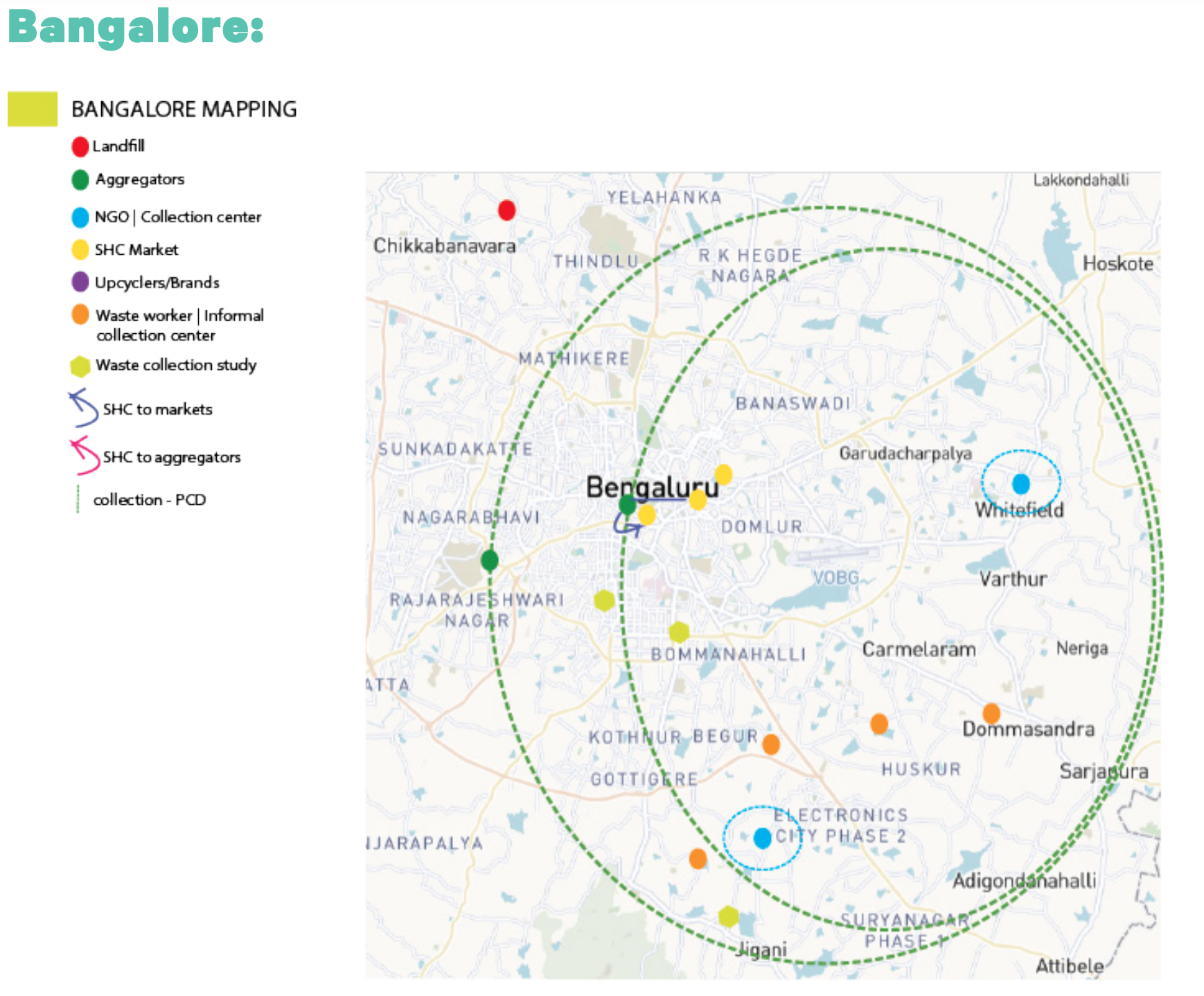
Illustration 39: Flow of domestic post-consumer waste in Bangalore
ANNEXURE 4: WASTE STUDY DONE BY SAAHAS ZERO WASTE TEAM
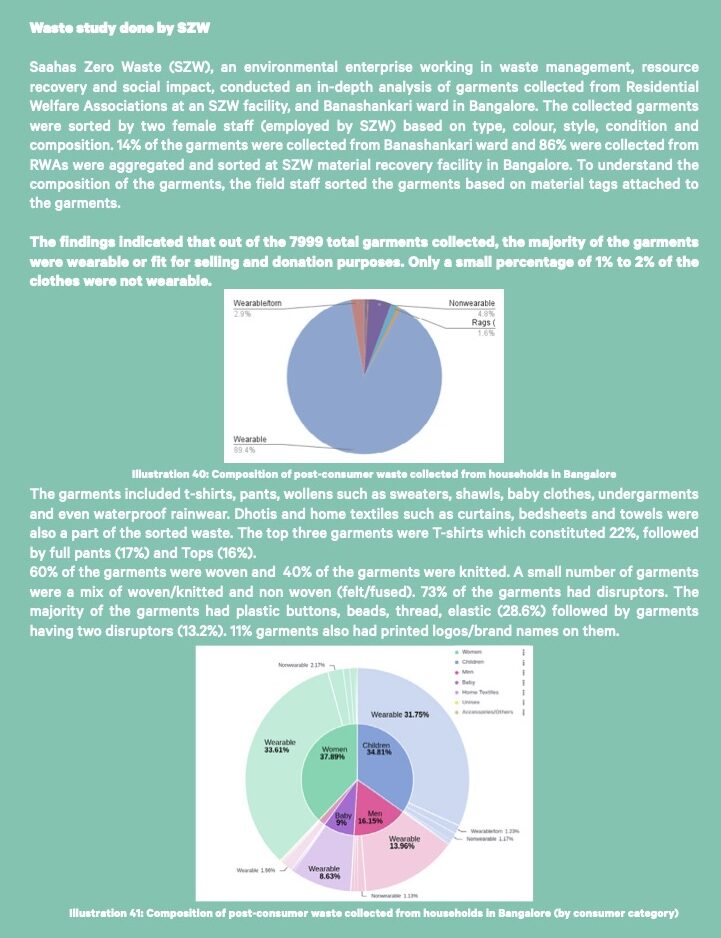
ANNEXURE 5: RESEARCH METHODOLOGY
Research Aims And Objectives
This study is the first in-depth attempt to understand the current textile waste material flow in India. Moreover, the report aims to identify technologies that can assist in mapping and sorting of waste to address the challenges in India, and then pilot the solutions to prove the efficacy of the technologies identified. The objective of the study is to build a roadmap for the implementation of these solutions along with brands, manufacturers, recyclers and other stakeholders of the industry. The study was undertaken keeping the three waste streams – pre-consumer, imported and domestic post-consumer in mind.
Team and Roles

The project was initiated by Fashion For Good, a global platform for innovation. FFG unites the entire fashion ecosystem, from brands, manufacturers and suppliers, to consumers, to collaborate and drive the change towards a circular industry. In this project, FFG served as an orchestrator and convener for all relevant stakeholders, while also producing communication output.
Sattva Consulting co-led the pre-consumer Waste Stream and led the imported waste streams. Sattva is an organisation driven by the mission to end poverty in our lifetime. Our work focuses on scalable solutions for sustainable social impact. They were responsible for the project coordination and consolidated analysis and reports from all workstreams and drafted the final report.
Saahas Zero Waste, a social enterprise, led the domestic post-consumer waste stream, capturing Bangalore and Delhi. They provide end-to-end waste management services and bring about environmental and social impact based on the principles of circular economy and global commitment to Sustainable Development Goals (SDG).
Reverse Resources co-led the pre-consumer, rolled out surveys and analysed data for the report. They are the innovators for the pre-consumer workstream of the project and will be working with FFG to conduct the pilot.
Research Methodologies

Sattva’s team conducted both primary and secondary research to understand the quantum and categories of waste. For the pre-consumer and imported waste streams, in-depth interviews were conducted with 120+ stakeholders in the value chain including traders and recyclers. The data was collected from several cities in the country including Ahmedabad, Amroha, Amritsar, Bangalore, Coimbatore, Delhi/NCR, Gandhidham, Kandla SEZ, Ludhiana, Mumbai, Panipat, Surat, Trirupur. A total of 12 upcyclers, 46 recyclers, 62 collectors, sorters and handlers, 12 textile manufacturers, 11 waste importers and 2 brands across all cities were interviewed for the research. For expert consultations, 8 distinguished personalities from the sector were consulted.
In order to gather secondary data for imported waste streams, the UN Comtrade Database for the year 2020 was used to analyse the quantum of waste imported to the country from various parts of the world.
Saahas Zero Waste’s survey team conducted desk based secondary research and reviewed existing secondary data available in the public domain such as research papers, government reports and studies, relevant laws, policies and guidelines applicable on a national and relevant state and city level, reports or scoping undertaken by credible agencies among others including data available with FFG relating to post consumer textile waste. They then identified the relevant stakeholders, conducted consumer disposal surveys and in-depth interviews along with site visits to understand the segregation levels, collection and transportation systems including primary collection from different waste generators and secondary transfer, processing and final disposal of textile waste, market linkages for end products for textile waste management systems. The data sets were reviewed and consolidated for the analysis phase.
In order to understand consumer disposal behaviour, a consumer survey of 570 consumers majorly from Delhi and Bangalore was done. Additionally , the Saahas Zero Waste team also conducted an in-depth analysis of 7999 garments collected from Residential Welfare Associations at a Saahas Zero Waste (SZW) facility, and Banashankari ward in Bangalore.
Reverse Resources used primary and secondary data to analyse the quantum and categories of pre- consumer textile waste in India. The quantitative data was collected from a sample of factories that received a link to the RR Platform from the Sattva team. The data was accumulated in the RR database and analysed accordingly.In addition to this the RR team used existing industry data and expertise to complete the data analysis and make sure it is within industry standards (as a means to compensate for the small sample size). Subsequently a data model was built covering main aspects of the Indian textile and garment industry (fibre composition usage, knit-woven industry split, waste/material ratios, et al.)
In order to understand the volume of textile material (fibre, yarn, fabric) being produced, imported, and transformed in the country RR used the UN Comtrade Database. From this database, the 2019 data was considered since it was the last full year of trading which was not affected by the Covid pandemic.
Waste/material ratios derived from the data model are then used with the secondary data to estimate the volumes of waste generated at each production process. All volumes and final estimates are represented on the Sankey diagram which displays yearly Ktons of material based on 2019 data.
